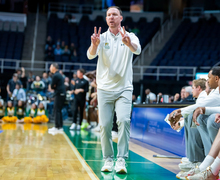Filmmakers of ‘What Happened’ exhibit use art as catharsis
Courtesy of Simon Liu
As part of the “What Happened” exhibit, the Everson Museum is streaming work by Luis Arnias, Simon Liu and Zhou Tao on their plaza projection system.
Get the latest Syracuse news delivered right to your inbox.
Subscribe to our newsletter here.
As Simon Liu watched the news in his New York City apartment in November 2019, he worried about his family members and his hometown Hong Kong.
The tense relationship between Hong Kong and China peaked as protesters clashed in the streets with police. The distance from his family was unsettling, and he felt the need to document what was happening. Liu returned to Hong Kong heartbroken. His homeland was nearly unrecognizable. The first moments, hours and days stuck with him.
“It’s a very strange feeling to have that be the last impression of the place,” he said.
Liu’s films “Signal 8” and “Happy Valley” will be on virtual display starting today as part of the Urban Video Project’s “What Happened” exhibition. Along with featuring Liu’s work, the exhibit at the Everson Museum Plaza features work from fellow filmmakers Luis Arnias and Zhou Tao. It’s an effort to represent the unprecedented times of the past year, said Anneka Herre, Urban Video Project’s program director.
Herre said the project began to form last summer when the pandemic and systemic racism became center points of society. Engaging with protests, the pandemic, state brutality, racialized violence, ecological disaster — in a way that left room for poetry, ambiguity and reflection — became a priority for the UVP, Herre said. She aimed to exemplify American exceptionalism amid current events, and having an international backdrop felt important to achieving that, she said.
These films give us a space in which to sit with and process confusion and uncertainty while we’re viewing the workAnneka Herre, program director for Urban Video Project
She hoped to resist the habit of instantly turning traumatic events into heated debates glorified by the 24-hour news cycle. The curators and artists aimed to create a show that would speak to what individuals, communities and the country has experienced recently, she said.
“Each of the artists has a great eye for the uncanniness of the world and works productively with ambiguity in these short films,” Herre said. “These films give us a space in which to sit with and process confusion and uncertainty while we’re viewing the work.”
In featuring different scenes based on Hong Kong, Liu uses reality to make the viewer think about “what a surreal space all large cities are,” Herre said. For Liu, documenting Hong Kong was a way for him to offer people from the city a means of catharsis or understanding of the mutual feelings they have for the city when it was calm, he said.
Conversely, Arnias and Tao use filmmaking to explore and challenge the sometimes-vague difference between fact and fiction, Herre said. Coming from a photography background and as someone who has been interested in street photography in the past, Arnias often needs photos to get his ideas out. He begins by walking around, looking, filming and mostly collecting motion images. Original ideas and shooting locations are organic.
Herres said Tao’s shots are extraordinary because of the cognitive dissonance they create in the viewer’s mind. At one moment, the viewer watches a crowd of people crammed on a street in Bangkok basking in a green glow. Then the shot turns to the military building a barricade, and suddenly violence erupts. She added that he purposefully leaves key information out of the frame, but still leaves enough “space in time” for the audience to make sense of the scene.
“You’re left feeling unsure: is it reality? Is it a film set? Is something bad happening, or is everything fine?” Herre said.
Arnias’ piece, “Terror Has No Shape,” which is on display as part of the exhibition, differs from his other work. Its origins arose without much inspiration –– or forced inspiration. More often than not, he acquires his inspiration by going out into the field without a clear understanding of his objective.
He shoots two or three rolls of film –– each around three minutes long –– with his Kodak 7266, sends them to a lab and then receives a file within a week. Once he receives his photos, he looks at the granular details to see what’s missing. He repeats the process until he finds a theme that sticks. But it’s all about the editing process, he said.
He focuses on the editing process most. The beginning and middle parts — determining what the film will actually be about and then grasping what technology will be necessary to execute the plan — can get complicated from time to time. But the editing process keeps everything on track, he said. It helps him to eventually arrive at a theme. Through the process, Arnias said, he’s able to see the “definitions” and what is lacking in his work.
“The idea of subjectivity and looking at your own neighborhood every day throughout a frame was dope,” Arnias said, referring to the work he did in college. “I am not a purist.”
Published on March 3, 2021 at 11:50 pm






